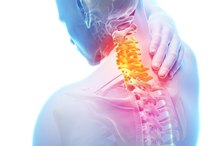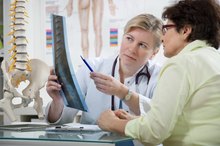Is Chiropractic Manipulation OK Post Spinal Fusion?
In spinal fusion surgery, an orthopedic surgeon removes the discs between two or more vertebrae and then fuses the bones together with screws. Over time, the bones graft together to immobilize that section of the spine. The purpose of immobilizing part of the spine is to correct conditions such as herniated disks and degenerative bone diseases that would damage the spinal nerves. Chiropractic manipulation works on the principle that you can treat or resolve several illnesses by adjusting or realigning the bones, including the spine. There is some debate as to whether you should have chiropractic manipulation after spinal fusion surgery 1.
If you are experiencing serious medical symptoms, seek emergency treatment immediately.
The Post-Surgical Healing Process
It can take at least three months for the fused bones to graft together. During that time, patients should avoid movements that bend, twist or put strain on the spinal bones and risk breaking the graft. Once the bones have grafted together, it can take another several months of physical therapy to strengthen the graft and the muscles surrounding the bones. Strengthening the graft is crucial in maintaining the integrity of the bones and immobilizing the spine. Depending on the patient’s health, it could take at least a year of combined convalescence and therapy to fully recover.
- It can take at least three months for the fused bones to graft together.
- Depending on the patient’s health, it could take at least a year of combined convalescence and therapy to fully recover.
Benefits of Chiropractic Manipulation
How to Fix a Herniated Disk in the Neck
Learn More
Chiropractors and chiropractic orthopedists contend that spinal fusion patients often continue to experience pain, and in some cases, their conditions worsen post-surgery. A case report published in the 2009 "Journal of the Academy of Chiropractic Orthopedists" said that patients who experience continued pain after lumbar fusion responded well to a combination of spinal adjustment and distraction decompression. Adam Tanase, D.C., a St. Louis-area chiropractor, advises that while chiropractors should not use rotational methods, or “twist-and-pop,” that fusion patients could benefit from other spinal manipulation techniques.
- Chiropractors and chiropractic orthopedists contend that spinal fusion patients often continue to experience pain, and in some cases, their conditions worsen post-surgery.
- Adam Tanase, D.C., a St. Louis-area chiropractor, advises that while chiropractors should not use rotational methods, or “twist-and-pop,” that fusion patients could benefit from other spinal manipulation techniques.
Risks of Chiropractic Manipulation
The Mayo Clinic contends that chiropractic manipulation is generally safe when performed by a licensed professional. However, they also warn that chiropractic manipulations have serious risks, including damage to the spinal nerves and brain stem strokes. Fusion patients could be at greater risk for injury, especially if the graft is not strong enough or if the chiropractor is not familiar with non-rotational methods for spinal manipulation.
The Best Option
Pros & Cons of Lumbar Spinal Fusion
Learn More
Individuals who have had spinal fusion surgery should avoid going to a chiropractor within the first year post-surgery. After the first year, you should consult with your surgeon and physical therapist to determine if the graft is strong enough to withstand chiropractic manipulation. To find a reputable chiropractor, get a referral from your surgeon or physical therapist or consult the American Chiropractic Association. When you meet with the chiropractor, advise him of your spinal fusion and ask him about the techniques he uses and if he is familiar with non-rotational methods of spinal manipulation.
- Individuals who have had spinal fusion surgery should avoid going to a chiropractor within the first year post-surgery.
- After the first year, you should consult with your surgeon and physical therapist to determine if the graft is strong enough to withstand chiropractic manipulation.
Related Articles
References
- Spine Health: Postoperative Care for Spinal Fusion Surgery
- Branney J, Breen AC. Does inter-vertebral range of motion increase after spinal manipulation? A prospective cohort study. Chiropr Man Therap. 2014;22:24. doi:10.1186/s12998-014-0024-9
- Haas M, Spegman A, Peterson D, Aickin M, Vavrek D. Dose response and efficacy of spinal manipulation for chronic cervicogenic headache: a pilot randomized controlled trial. Spine J. 2010;10(2):117-28. doi:10.1016/j.spinee.2009.09.002
- Digiorgi D. Spinal manipulation under anesthesia: a narrative review of the literature and commentary. Chiropr Man Therap. 2013;21(1):14. doi:10.1186/2045-709X-21-14
- American Chiropractic Association. American Board of Chiropractic Specialties (ABCS).
- Margach RW. Chiropractic functional neurology: An introduction. Integr Med (Encinitas). 2017;16(2):44-45.
- Bryans R, Descarreaux M, Duranleau M, et al. Evidence-based guidelines for the chiropractic treatment of adults with headache. J Manipulative Physiol Ther 2011; 34: 274-89. doi:10.1016/j.jmpt.2011.04.008
- Centers for Disease Control and Prevention. Use of yoga, meditation, and chiropractors among U.S. adults aged 18 and over.
- National Center for Complementary and Integrative Health. Chiropractic: in depth. Updated April 2019.
- National Health Statistics Report. Trends in the use of complementary health approaches among adults: United States, 2002–2012. Updated February 10, 2015.
- University of Minnesota. Taking Charge of Your Health & Wellbeing. How can I find a qualified chiropractor?
Resources
Writer Bio
Max Whitmore is a personal trainer with more than three years experience in individual and group fitness. Whitmore has a Bachelor of Arts in English literature from the University of Cincinnati, fitness certifications and dietetics training from Cincinnati State Technical and Community College. Whitmore has written for several online publishers.









